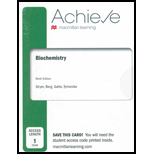
BIOCHEMISTRY-ACHIEVE (1 TERM)
9th Edition
ISBN: 9781319402853
Author: BERG
Publisher: MAC HIGHER
expand_more
expand_more
format_list_bulleted
Concept explainers
Question
Chapter 30, Problem 11P
Interpretation Introduction
Interpretation:
The distance of transcription bubble on E.coli genes which are being transcribed at a maximal rate should be determined.
Concept introduction:
RNA synthesis (transcription) is the synthesis of an RNA molecule from the nucleotide’s adenine, cytosine, guanine, or uracil. The
Expert Solution & Answer
Want to see the full answer?
Check out a sample textbook solution
Students have asked these similar questions
I am more confused. how about we start from begining, you post answers on here, and then we go from there?
1. Identify the open reading frame in the following DNA sequence, the protein that this gene encodes for, its function, and the source.
2. "Look carefully at the DNA sequence and identify the start site for transcription"
3.
Click on the DNA sequence from the start site of transcription, select all of the sequence, and copy the sequence.
Go to the National Center for Biotechnology Information (NCBI) website http://www.ncbi.nlm.nih.gov/. Click on BLAST on the right-hand side under “Popular Resources.” BLAST is a program that will allow you to find the protein sequence for the DNA sequence (gene) you submit. Next click on blastx (translated nucleotide protein).
Paste the DNA sequence into the box under “Entry Query Sequence.” Scroll down and click BLAST. The search may take a few seconds; the page will keep updating until the search is completed. You do not need to enter any…
E32. In the technique of DNase I footprinting, the binding of a protein
to a region of DNA protects that region from digestion by DNase I
by blocking the ability of DNase I to gain access to the DNA. In
the DNase I footprinting experiment shown here, a researcher
began with a sample of cloned DNA 400 bp in length. This DNA
contained a eukaryotic promoter for RNA polymerase II. The
assembly of general transcription factors and RNA polymerase II
at the core promoter is described in Chapter 12 (see Figure 12.14).
For the sample loaded in lane 1, no proteins were added. For the
sample loaded in lane 2, the 400-bp fragment was mixed with
RNA polymerase II plus TFIID and TFIIB.
2
400
350
250
175
50
Which region of this 400-bp fragment of DNA is bound by RNA
polymerase II and TFIID and TFIIB?
||
III ||| | ||||
protein. You create a mouse line with Cas9 under control of a brain-specific enhancer, while the short
guide RNA complementary to the first exon of Gene Y is expressed in all tissues. You subsequently
sequence Gene Y in both brain and liver tissue. What would expect in each tissue? You can assume
that the CRISPRICas9 system will impact both copies of Gene Y in cells, and that the first exon of
Gene Y is necessary for Gene Ys function.
a. Liver: Functional Gene Y; Brain: Functional Gene Y
b. Liver: Nonfunctional Gene Y; Brain: Funtional Gene Y
c. Liver: Functional Gene Y; Brain: Nonfunctional Gene Y
d. Liver: Nonfunctional Gene Y; Brain: Nonfunctional Gene Y
Chapter 30 Solutions
BIOCHEMISTRY-ACHIEVE (1 TERM)
Knowledge Booster
Learn more about
Need a deep-dive on the concept behind this application? Look no further. Learn more about this topic, biochemistry and related others by exploring similar questions and additional content below.Similar questions
- Explain well. Asaparrow_forwardDNA: 5’-CTCTACTATAAACTCAATAGGTCC-3’ Draw a box around the sequence where RNA polymerase will bind to the DNA. What is this sequence called? Will transcription start at this sequence, to the left of this sequence (“upstream”) or, to the right of this sequence (“downstream”)? Draw a small arrow above the DNA strand where transcription will begin. Which DNA strand will RNA polymerase transcribe? Highlight this strand with your highlighter. (Hint: RNA pol is similar to DNA pol because it can only make new RNA in the 5’ to 3’ direction. Draw in an arrow to show the direction that RNA polymerase will move along the DNA strand.arrow_forwardPlease ASAP. Thank youarrow_forward
- Explain well. Asaparrow_forwardE22. The method of Northern blotting is used to determine the amount and size of a particular RNA transcribed in a given cell type. Alternative splicing (discussed in Chapter 12) produces mRNAs of different lengths from the same gene. The Northern blot shown here was made using a DNA probe that is complementary to the MRNA encoded by a particular gene. The mRNA in lanes 1 through 4 was isolated from different cell types, and equal amounts of total cellular MRNA were added to each lane. 2 3 4 Lane 1: MRNA isolated from nerve cells Lane 2: MRNA isolated from kidney cells Lane 3: MRNA isolated from spleen cells Lane 4: MRNA isolated from muscle cells Explain these results. | |arrow_forwardmatch.arrow_forward
arrow_back_ios
SEE MORE QUESTIONS
arrow_forward_ios
Recommended textbooks for you
 BiochemistryBiochemistryISBN:9781305577206Author:Reginald H. Garrett, Charles M. GrishamPublisher:Cengage Learning
BiochemistryBiochemistryISBN:9781305577206Author:Reginald H. Garrett, Charles M. GrishamPublisher:Cengage Learning

Biochemistry
Biochemistry
ISBN:9781305577206
Author:Reginald H. Garrett, Charles M. Grisham
Publisher:Cengage Learning